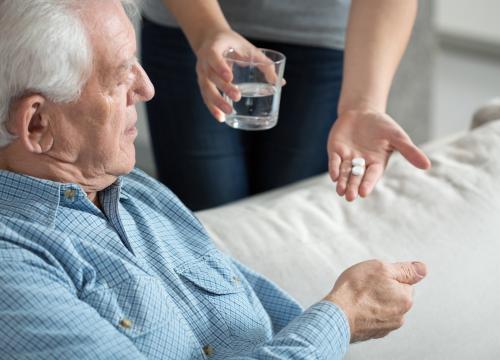Pain
💡 Quick Summary
-
Pain is common in Parkinson’s and can stem from muscle rigidity, posture changes, nerve damage or dystonia.
-
Affects areas including the spine, hands and feet.
-
PD-related skeletal changes — such as stooped posture, frozen shoulder, flexed fingers or toes and low bone density — can cause discomfort, imbalance and increase fall or fracture risk.
-
Managing pain and bone health involves optimizing PD medications, staying active with regular exercise, maintaining good posture, checking bone density and vitamin D levels, and seeking therapies.

Pain can occur in people with Parkinson's disease (PD). As Parkinson’s progresses, it is common to experience changes in the spine, hands and feet that can be uncomfortable.
Understanding Pain
Parkinson’s disease pain is divided into five categories:
- Musculoskeletal: Musculoskeletal pain is due to the disease affecting the bones, muscles, ligaments, tendons and nerves. It can occur suddenly or be long-lasting and can occur in one area or several.
- Neuropathic/radicular: Neuropathic/radicular pain is due to damage to nerves occurring anywhere from where the fibers leave the spinal cord to where they end in the skin.
- Dystonic: Dystonic pain is from sustained or repetitive muscle twisting, spasm or cramp that can occur at different times of day and in different stages of Parkinson’s.
- Akathisia: Akathisia is the feeling of restlessness or inability to be still.
- Central Pain: Central pain is pain due to the pathways which control sensation and pain in the brain, brainstem, and spinal cord not working properly.
Nearly every person who lives with PD will experience some degree of muscle rigidity. Common experiences include bending of the neck, curling of the trunk with slumping of the shoulders and bending at the wrists, fingers, elbows, hips and knees. These changes may progress over time.
A third or more people with Parkinson’s eventually experience changes in posture, although this occurs most often in those with advanced PD. Some people experience severe postural changes with extreme leaning forward or to one side.
Other common changes include dystonia, muscle spasms, and cramps that are particularly common in the feet. Osteoporosis can also occur and lead to weakened bones which can increase risk of falls and fractures. It is important to look at the impact of orthopedic surgeries for non-PD related spine deformities, hip and knee replacement, and other bone problems. Although people with Parkinson's can benefit from such surgeries, they may have a longer and more complicated recovery than people without PD.
Rigidity, weakened muscles, and involuntary muscle contractions (dystonia) can cause painful deformities for people with PD. A tilted or twisted spine can also throw a person off balance and increase the risk of falling.
Common Skeletal & Bone Changes with PD
- Frozen shoulder: stiffness, pain and loss of range of movement in the shoulder, many people experience this symptom before a PD diagnosis.
- Flexed fingers, toes or feet (striatal hand and foot): one finger may extend, the thumb may fold inwards, fingers may clamp down onto the palm. In the leg, the foot may flex down or turn in, the big toe may flex upward while the other toes curl under.
- Stooped posture (camptocormia): the spine bends forward when walking, in the most severe cases by as much as 90 degrees. This posture arises because the hips and knees are flexed and will go away when lying down.
- Leaning sideways (Pisa syndrome): involuntarily tilting of the trunk to one side when sitting, standing or walking; always to the same side.
- Scoliosis: sideways twisting, or curvature, of the spine.
- Dropped head (anterocollis): the head and neck flex forward; the chin may drop all the way down to the sternum or breastbone (more common in multiple system atrophy than PD).
- Bone fractures: people with PD are at risk of broken bones from falling, especially from landing on the hip. Kneecap fractures also are common, painful and sometimes overlooked.
- Low bone density/osteoporosis: bones may become weak and at risk for osteoporosis from lack of weight-bearing exercise, like walking, and from too little calcium and vitamin D. Other risk factors for osteoporosis include older age, female sex, low body weight, and smoking. A person with PD who has osteoporosis is more likely to break a bone if they fall.
Other Symptoms: Aging or PD?
Because the biggest risk factor for developing PD is age (the average age of diagnosis is 60), skeletal problems associated with aging are often experienced by people with PD. While it is not clear that PD increases the risk or even the severity of these other skeletal conditions, the problems of PD can make the symptoms of these conditions more prominent.
- Osteoarthritis, the joint damage associated with general wear and tear on the joints, is nearly universal in aging. Osteoarthritis tends to affect larger joints such as the hip and knee.
- Arthritis of the spine is also very common. This may contribute to the development of spinal stenosis, narrowing of the canal in the spine that houses the spinal cord. In severe cases, spinal stenosis causes damage to the nerves as they exit the spine or even to the spinal cord itself.
- Disorders of the fibrous discs between the bones of the spine can also cause pain, or limb numbness or weakness.
Therapies
Medical therapies can help relieve the rigidity and muscle contractions that contribute to changes in posture. The approach to therapy very much depends on a person’s unique symptoms and overall health. Your doctor may advise:
Tips for Maintaining Healthy Bones
Keeping your bones strong can ease pain.
- Talk to your doctor about your PD medication changes that may ease skeletal or spine issues and strategies for optimizing medications to ensure they are most effective for PD.
- Ask your primary care doctor about having your bone-mineral density tested. If it is low, medications are available to help maintain or increase it.
- Discuss testing your blood level of vitamin D with your physician. If it is low, follow your doctor’s advice on taking supplements.
- Reduce the risk of falls by making the home safer with the advice of an occupational therapist and using the correct assistive devices (including different types of walkers or canes) when needed as instructed by a physical therapist
- Get active and keep moving. Exercise helps maintain strong bones and can ease dystonia among other symptoms. There is no one-size-fits-all exercise — whatever you enjoy and can do is the right exercise. Try to be active at least 30-45 minutes daily. Walking, swimming, yoga, Tai chi, and dancing are all good choices.
- See a physical therapist for advice on how to stretch, strengthen, and relax your muscles and for a program of exercises tailored to your own PD symptoms.
- Ask your doctor about detecting changes in posture early, when they can be treated and before they become permanent.
- Visit your doctor for regular physicals to rule out causes of pain unrelated to PD or changes in the spine unrelated to PD.
- Alternative or complementary therapies may be helpful in some cases. For example, acupuncture or massage can help some people with pain and may be considered.
Page reviewed by Dr. Chauncey Spears, Clinical Assistant Professor and Dr. Amelia Heston, Movement Disorders Fellow at the University of Michigan.
Related Materials
Related Blog Posts

A Beginner's Guide to Managing Pain Through Mindfulness

PD and Medication: Advancing Treatment
